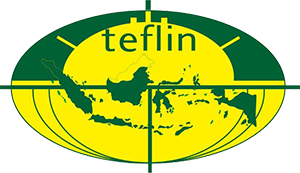Integrating Digital Literacy in English for Specific Purposes (ESP) Instruction Via English for Law e-module
Abstract
Nowadays, integration of technology through digital literacy in English instruction is demanded highly, but in practice, digital material like electronic modules still lacks investigation, especially in the ESP context. Therefore, this qualitative study tries to describe the digital literacy demand related to the material in ESP teaching and the implementation of digitalized based ESP material to facilitate law students’ digital literacy. 25 law students were involved as participants, with the questionnaires and interviews as the primary data and class observation as the secondary data. The results reveal that ESP language-teaching process demands digitalized material which facilitates the students’ needs in enhancing their English skills by exploring authentic learning sources digitally. The implementation of the English for Law e-module facilitates students’ digital literacy, especially in accessing the digital material in the e-module by 70% of the whole participants, 57,7 % of students use their digital literacy for finishing the lectures assignment, and 74% of students able to overcome their digital obstacle independently. The finding recommends the utilization of digitalized material based on e-module to cultivate the students’ digital literacy in ESP instruction.
Keywords
Full Text:
PDFReferences
Belz, J. A. (2002). Social dimensions of telecollaborative foreign language study. Language Learning & Technology, 6(1), 60–81. https://hdl.handle.net/1805/2658
Crowe, S., Cresswell, K., Robertson, A., Huby, G., Avery, A., & Sheikh, A. (2011). The case study approach. BMC Medical Research Methodology, 11(1), 100. https://doi.org/10.1186/1471-2288-11-100
Demirkan, O. (2019). Pre- service teachers’ views about digital teaching materials. Educational Policy Analysis and Strategic Research, 4(1), 40–60. https://doi.org/https://doi.org/10.29329/epasr.2019.186.3
Dudley-Evans, T., & M.J, S. J. (1998). Developments in English for specific purposes: A multi-disciplinary approach. Cambridge University Press. https://assets.cambridge.org/97805215/96756/excerpt/9780521596756_excerpt.pdf
Hatlevik, O., & Christophersen, K. (2013). Digital competence at the beginning of upper secondary school: Identifying factors explaining digital inclusion. Computers & Education, 63, 240–247. https://doi.org/https://doi.org/10.1016/j.compedu.2012.11.015
Ilmi, R., Arnawa, I. M., Yerizon, & Bakar, N. N. (2021). Development of an Android-based for math e-module by using Adobe Flash professional CS6 for grade X Students of senior high school. Journal of Physics: Conference Series, 1742(1). https://doi.org/https://doi.org/10.1088/1742-6596/1742/1/012026.
Isda, I. D., & Imran. (2021). The effect of using blended learning model on enhancing students’ speaking skill in senior high schools. JOLLT (Journal of Languages and Language Teaching), 9(1), 92–98. https://doi.org/https://doi.org/10.33394/jollt.v%vi%i.2921
Luna, R. . (2018). Integrating information and communication technologies in English for specific purposes. Springer International Publishing. https://doi.org/https://www.revistaiberica.org/index.php/iberica/article/view/104
Mahapatra, S. K. (2020). Impact of digital technology training on english for science and technology teachers in India. RELC Journal, 51(1), 117–133. https://doi.org/https://doi.org/10.1177/0033688220907401
Miles, M. B., & Huberman, M. (2014). Qualitative data analysis (SAGE (ed.)). https://opac.perpusnas.go.id/DetailOpac.aspx?id=498252
Moro, J. (2018). The emergence of digital course materials in higher education and their effectiveness in teaching and engaging students. Publishing Research Quarterly, 34, 417–429. https://doi.org/https://doi.org/10.1007/s12109-018-9594-z
Mudra, H. (2020). Digital literacy among young learners: How do EFL teachers and learners view its benefits and barriers ? Teaching English with Technology, 20(3), 3–24. https://eric.ed.gov/?id=EJ1264169
Mudure-Jacob, I. (1997). Digital literacy: From multi-functional skills to overcoming challenges in teaching ESP. Astra Salvensis, VII(14), 59–70. https://doi.org/https://doi.org/10.1145/3416797.3416846
Pernia, E. (2008). Strategy framework for promoting ICT literacy in the Asia-Pacific region. Thailand: UNESCO. http://119.82.251.165:8080/xmlui/handle/123456789/34
Pratama, W. A., Hartini, S., & Misbah. (2019). Analisis literasi digital siswa melalui penerapan e-learning berbasis schoology. Jurnal Inovasi Dan Pembelajaran Fisika, 6(1). https://garuda.kemdikbud.go.id/documents/detail/1011092
Purnamasari, N., Siswanto, S., & Malik, S. (2020). E-module as an emergency-innovated learning source during the Covid-19 outbreak. Psychology, Evaluation, and Technology in Educational Research, 3(1), 1–8. https://doi.org/https://doi.org/10.33292/petier.v3i1.53.
Sargeant, B. (2015). What is an ebook? What is a book app? And why should we care? An analysis of contemporary digital picture books. Children’s Literature in Education, 48(4), 454–466. https://doi.org/https://doi.org/10.1007/s10583-015-9243-5
Son, J.-B. (2015). Digital literacy. http://drjbson.com/projects/dl/
Song, G., & Ling, C. (2011). Users’ attitude and strategies in information management with multiple computers. International Journal of Human-Computer Interaction, 27(8), 762–792. https://doi.org/https://doi.org/10.1080/10447318.2011.555307
Starkey, L. (2011). Evaluating learning in the 21st century: A digital age learning matrix. Technology, Pedagogy and Education, 20(1), 19–39. https://doi.org/https://doi.org/10.1080/1475939X.2011.554021
Yokota, J., & Teale, W. H. (2014). Picture books and the digital world: Educators making informed choices. The Reading Teacher, 67(8), 577–585. https://doi.org/https://doi.org/10.1002/trtr.1262
DOI: http://dx.doi.org/10.21043/jetli.v6i1.19293
Refbacks
- There are currently no refbacks.
Copyright (c) 2023 Journal of English Teaching and Learning Issues







